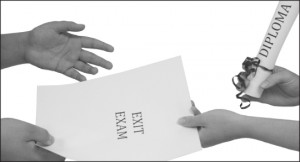Taking the Collegiate Assessment of Academic Proficiency test is the prospective graduates’ last hurdle before receiving a degree.
By: Andrea Royals
-News Editor-
 After spending several semesters studying for quizzes, collaborating in group projects, writing essays and listening to lecture after lecture, the tasks of a student seeking an associate degree at STLCC-Meramec are not quite finished. Students are required to take the Collegiate Assessment of Academic Proficiency (CAAP) Test, an exam given to all prospective graduates.
After spending several semesters studying for quizzes, collaborating in group projects, writing essays and listening to lecture after lecture, the tasks of a student seeking an associate degree at STLCC-Meramec are not quite finished. Students are required to take the Collegiate Assessment of Academic Proficiency (CAAP) Test, an exam given to all prospective graduates.
However future graduates may fear not! The exam is an evaluation of the General Education Program at Meramec and does not affect student grade point averages, said Ray Eberle-Mayse, manager of the Assessment Center.
Through the CAAP test, areas of general education requirements, including writing, reading, science, math, and critical thinking are evaluated. According to the Assessment Center, the test allows the college to measure what future graduates have learned in areas critical to professional success.
“We look at the results of the test as a whole by subject area,” said Eberle-Mayse.
If a student was tested on the critical thinking part of the exam, the assessment center would be concerned with the critical thinking scores of all the students who took the test in a particular academic year, he said, explaining that the CAAP Test does not reflect the abilities of a certain student over another.
Rather, the test scores from students at Meramec are collected and evaluated based upon national scores from similar colleges and universities across the country over a period of five years.
This assessment is one of several resources that help general education faculty to determine the effectiveness of the current curriculum. “This is one of a number of pieces of information faculty might utilize to determine what, if anything, they might do differently or better,” Eberle-Mayse said. Professors may also evaluate assignments and activities done in class to measure the effectiveness of the curriculum.
“In all cases, Meramec students score at or above the national average,” Eberle-Mayse said, praising mathematics as the strongest area in which Meramec students test. “Students who don’t take it seriously sometimes don’t do it very well. While it doesn’t affect their grade point average, we just ask students to give it an honest effort.”
Students are not tested in each of the five areas of general education but given a section of the test through a random sample. “It is kind of luck of the draw,” Eberle-Mayse said. “The test is not based upon strength or program of study.”
If a student refuses to take the exam, he or she may not graduate with an associate degree. Students seeking certificates in a particular area are not required to take the exam, Eberle-Mayse said, since certificate programs do not always incorporate the core components of the General Education Program.
After registering for graduation, students in their last semester at Meramec will receive a notification from the Assessment Center asking them to choose one of several allotted time slots to complete the test throughout the semester.
The multiple choice assessment takes an hour to complete and students are asked to bring photo identification and student identification number to the allotted testing hour. The Meramec curriculum does not require that students complete the essay portion of the assessment. Students wishing to view sample questions of the exam prior to the testing date may visit http://act.org/caap.








